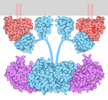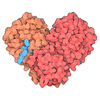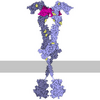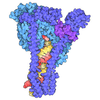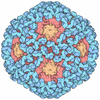[English] 日本語
 Yorodumi
Yorodumi- PDB-9rkc: Crystal Structure of ACBI4-mediated ternary complex of KRAS G12D ... -
+ Open data
Open data
- Basic information
Basic information
| Entry | Database: PDB / ID: 9rkc | ||||||
|---|---|---|---|---|---|---|---|
| Title | Crystal Structure of ACBI4-mediated ternary complex of KRAS G12D C118S GDP with pVHL:ElonginC:ElonginB | ||||||
 Components Components |
| ||||||
 Keywords Keywords | ONCOPROTEIN / KRAS / TPD / PROTAC / VHL / ternary complex | ||||||
| Function / homology |  Function and homology information Function and homology informationregulation of cellular response to hypoxia / RHOBTB3 ATPase cycle / negative regulation of receptor signaling pathway via JAK-STAT / transcription elongation factor activity / target-directed miRNA degradation / elongin complex / Replication of the SARS-CoV-1 genome / VCB complex / Cul5-RING ubiquitin ligase complex / response to mineralocorticoid ...regulation of cellular response to hypoxia / RHOBTB3 ATPase cycle / negative regulation of receptor signaling pathway via JAK-STAT / transcription elongation factor activity / target-directed miRNA degradation / elongin complex / Replication of the SARS-CoV-1 genome / VCB complex / Cul5-RING ubiquitin ligase complex / response to mineralocorticoid / GMP binding / Cul2-RING ubiquitin ligase complex / forebrain astrocyte development / intracellular membraneless organelle / LRR domain binding / regulation of synaptic transmission, GABAergic / negative regulation of epithelial cell differentiation / response to isolation stress / SUMOylation of ubiquitinylation proteins / response to gravity / epithelial tube branching involved in lung morphogenesis / type I pneumocyte differentiation / Rac protein signal transduction / positive regulation of Rac protein signal transduction / Signaling by RAS GAP mutants / Signaling by RAS GTPase mutants / Activation of RAS in B cells / myoblast proliferation / skeletal muscle cell differentiation / Pausing and recovery of Tat-mediated HIV elongation / Tat-mediated HIV elongation arrest and recovery / RAS signaling downstream of NF1 loss-of-function variants / negative regulation of transcription elongation by RNA polymerase II / RUNX3 regulates p14-ARF / HIV elongation arrest and recovery / Pausing and recovery of HIV elongation / positive regulation of glial cell proliferation / SOS-mediated signalling / Activated NTRK3 signals through RAS / Activated NTRK2 signals through RAS / SHC1 events in ERBB4 signaling / cardiac muscle cell proliferation / Signalling to RAS / negative regulation of signal transduction / Activated NTRK2 signals through FRS2 and FRS3 / SHC-related events triggered by IGF1R / Tat-mediated elongation of the HIV-1 transcript / Estrogen-stimulated signaling through PRKCZ / Formation of HIV-1 elongation complex containing HIV-1 Tat / glial cell proliferation / SHC-mediated cascade:FGFR3 / ubiquitin-like ligase-substrate adaptor activity / MET activates RAS signaling / Formation of HIV elongation complex in the absence of HIV Tat / SHC-mediated cascade:FGFR2 / PTK6 Regulates RHO GTPases, RAS GTPase and MAP kinases / Signaling by PDGFRA transmembrane, juxtamembrane and kinase domain mutants / Signaling by PDGFRA extracellular domain mutants / SHC-mediated cascade:FGFR4 / Erythropoietin activates RAS / SHC-mediated cascade:FGFR1 / Signaling by FGFR4 in disease / RNA Polymerase II Transcription Elongation / FRS-mediated FGFR3 signaling / Signaling by CSF3 (G-CSF) / Formation of RNA Pol II elongation complex / Signaling by FLT3 ITD and TKD mutants / FRS-mediated FGFR2 signaling / FRS-mediated FGFR4 signaling / p38MAPK events / FRS-mediated FGFR1 signaling / Signaling by FGFR3 in disease / protein-membrane adaptor activity / Tie2 Signaling / negative regulation of TORC1 signaling / striated muscle cell differentiation / Signaling by FGFR2 in disease / RNA Polymerase II Pre-transcription Events / GRB2 events in EGFR signaling / SHC1 events in EGFR signaling / Signaling by FLT3 fusion proteins / FLT3 Signaling / Signaling by FGFR1 in disease / EGFR Transactivation by Gastrin / NCAM signaling for neurite out-growth / homeostasis of number of cells within a tissue / CD209 (DC-SIGN) signaling / GRB2 events in ERBB2 signaling / Downstream signal transduction / Insulin receptor signalling cascade / SHC1 events in ERBB2 signaling / Ras activation upon Ca2+ influx through NMDA receptor / negative regulation of autophagy / protein serine/threonine kinase binding / response to glucocorticoid / Constitutive Signaling by Overexpressed ERBB2 / Signaling by phosphorylated juxtamembrane, extracellular and kinase domain KIT mutants / VEGFR2 mediated cell proliferation / transcription corepressor binding / small monomeric GTPase Similarity search - Function | ||||||
| Biological species |  Homo sapiens (human) Homo sapiens (human) | ||||||
| Method |  X-RAY DIFFRACTION / X-RAY DIFFRACTION /  SYNCHROTRON / SYNCHROTRON /  MOLECULAR REPLACEMENT / Resolution: 2.19 Å MOLECULAR REPLACEMENT / Resolution: 2.19 Å | ||||||
 Authors Authors | Karolak, N.K. / Ciulli, A. | ||||||
| Funding support |  Germany, 1items Germany, 1items
| ||||||
 Citation Citation |  Journal: J.Am.Chem.Soc. / Year: 2025 Journal: J.Am.Chem.Soc. / Year: 2025Title: Identification of a Highly Cooperative PROTAC Degrader Targeting GTP-Loaded KRAS(On) Alleles. Authors: Vetma, V. / Puoti, I. / Karolak, N.K. / Chakraborti, S. / Diers, E. / Girardi, E. / Khan, S. / Kidd, G. / Kropatsch, K.G. / Mclennan, R. / O'Connor, S. / Samwer, M. / Trainor, N. / ...Authors: Vetma, V. / Puoti, I. / Karolak, N.K. / Chakraborti, S. / Diers, E. / Girardi, E. / Khan, S. / Kidd, G. / Kropatsch, K.G. / Mclennan, R. / O'Connor, S. / Samwer, M. / Trainor, N. / Whitworth, C. / Wijaya, A.J. / Wong, J.Y.F. / Zollman, D. / Farnaby, W. / Popow, J. / Ciulli, A. / Ettmayer, P. / McAulay, K. | ||||||
| History |
|
- Structure visualization
Structure visualization
| Structure viewer | Molecule:  Molmil Molmil Jmol/JSmol Jmol/JSmol |
|---|
- Downloads & links
Downloads & links
- Download
Download
| PDBx/mmCIF format |  9rkc.cif.gz 9rkc.cif.gz | 463.7 KB | Display |  PDBx/mmCIF format PDBx/mmCIF format |
|---|---|---|---|---|
| PDB format |  pdb9rkc.ent.gz pdb9rkc.ent.gz | Display |  PDB format PDB format | |
| PDBx/mmJSON format |  9rkc.json.gz 9rkc.json.gz | Tree view |  PDBx/mmJSON format PDBx/mmJSON format | |
| Others |  Other downloads Other downloads |
-Validation report
| Summary document |  9rkc_validation.pdf.gz 9rkc_validation.pdf.gz | 1.9 MB | Display |  wwPDB validaton report wwPDB validaton report |
|---|---|---|---|---|
| Full document |  9rkc_full_validation.pdf.gz 9rkc_full_validation.pdf.gz | 1.9 MB | Display | |
| Data in XML |  9rkc_validation.xml.gz 9rkc_validation.xml.gz | 41.3 KB | Display | |
| Data in CIF |  9rkc_validation.cif.gz 9rkc_validation.cif.gz | 54 KB | Display | |
| Arichive directory |  https://data.pdbj.org/pub/pdb/validation_reports/rk/9rkc https://data.pdbj.org/pub/pdb/validation_reports/rk/9rkc ftp://data.pdbj.org/pub/pdb/validation_reports/rk/9rkc ftp://data.pdbj.org/pub/pdb/validation_reports/rk/9rkc | HTTPS FTP |
-Related structure data
| Related structure data |  9rk8C  9rkeC  9rkjC  9rknC C: citing same article ( |
|---|---|
| Similar structure data | Similarity search - Function & homology  F&H Search F&H Search |
- Links
Links
- Assembly
Assembly
| Deposited unit | 
| ||||||||||||
|---|---|---|---|---|---|---|---|---|---|---|---|---|---|
| 1 | 
| ||||||||||||
| 2 | 
| ||||||||||||
| Unit cell |
|
- Components
Components
-Protein , 4 types, 8 molecules AEBFCGDH
| #1: Protein | Mass: 11748.406 Da / Num. of mol.: 2 Source method: isolated from a genetically manipulated source Source: (gene. exp.)  Homo sapiens (human) / Gene: ELOB, TCEB2 / Production host: Homo sapiens (human) / Gene: ELOB, TCEB2 / Production host:  #2: Protein | Mass: 10974.616 Da / Num. of mol.: 2 Source method: isolated from a genetically manipulated source Source: (gene. exp.)  Homo sapiens (human) / Gene: ELOC, TCEB1 / Production host: Homo sapiens (human) / Gene: ELOC, TCEB1 / Production host:  #3: Protein | Mass: 18702.291 Da / Num. of mol.: 2 Source method: isolated from a genetically manipulated source Source: (gene. exp.)  Homo sapiens (human) / Gene: VHL / Production host: Homo sapiens (human) / Gene: VHL / Production host:  #4: Protein | Mass: 19370.781 Da / Num. of mol.: 2 Source method: isolated from a genetically manipulated source Source: (gene. exp.)  Homo sapiens (human) / Gene: KRAS, KRAS2, RASK2 / Production host: Homo sapiens (human) / Gene: KRAS, KRAS2, RASK2 / Production host:  |
|---|
-Non-polymers , 4 types, 54 molecules 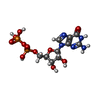

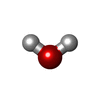


| #5: Chemical | Mass: 970.198 Da / Num. of mol.: 2 / Source method: obtained synthetically / Formula: C50H63N15O4S / Feature type: SUBJECT OF INVESTIGATION #6: Chemical | #7: Chemical | #8: Water | ChemComp-HOH / | |
|---|
-Details
| Has ligand of interest | Y |
|---|---|
| Has protein modification | N |
-Experimental details
-Experiment
| Experiment | Method:  X-RAY DIFFRACTION / Number of used crystals: 1 X-RAY DIFFRACTION / Number of used crystals: 1 |
|---|
- Sample preparation
Sample preparation
| Crystal | Density Matthews: 2.47 Å3/Da / Density % sol: 50.16 % |
|---|---|
| Crystal grow | Temperature: 293.15 K / Method: vapor diffusion, sitting drop Details: 0.2 M Na2SO4, 15% w/v PEG 3,350, 0.1 M BIS-TRIS propane pH 7.79 |
-Data collection
| Diffraction | Mean temperature: 100 K / Serial crystal experiment: N |
|---|---|
| Diffraction source | Source:  SYNCHROTRON / Site: SYNCHROTRON / Site:  Diamond Diamond  / Beamline: I24 / Wavelength: 0.6199 Å / Beamline: I24 / Wavelength: 0.6199 Å |
| Detector | Type: DECTRIS EIGER2 X CdTe 9M / Detector: PIXEL / Date: Apr 24, 2025 |
| Radiation | Protocol: SINGLE WAVELENGTH / Monochromatic (M) / Laue (L): M / Scattering type: x-ray |
| Radiation wavelength | Wavelength: 0.6199 Å / Relative weight: 1 |
| Reflection | Resolution: 2.19→44.81 Å / Num. obs: 59951 / % possible obs: 97.6 % / Redundancy: 7.1 % / Biso Wilson estimate: 45.12 Å2 / CC1/2: 0.989 / Net I/σ(I): 4.1 |
| Reflection shell | Resolution: 2.19→2.273 Å / Num. unique obs: 4959 / CC1/2: 0.318 |
- Processing
Processing
| Software |
| |||||||||||||||||||||||||||||||||||||||||||||||||||||||||||||||||||||||||||||||||||||||||||||||||||||||||
|---|---|---|---|---|---|---|---|---|---|---|---|---|---|---|---|---|---|---|---|---|---|---|---|---|---|---|---|---|---|---|---|---|---|---|---|---|---|---|---|---|---|---|---|---|---|---|---|---|---|---|---|---|---|---|---|---|---|---|---|---|---|---|---|---|---|---|---|---|---|---|---|---|---|---|---|---|---|---|---|---|---|---|---|---|---|---|---|---|---|---|---|---|---|---|---|---|---|---|---|---|---|---|---|---|---|---|
| Refinement | Method to determine structure:  MOLECULAR REPLACEMENT / Resolution: 2.19→44.81 Å / SU ML: 0.4759 / Cross valid method: FREE R-VALUE / σ(F): 1.34 / Phase error: 33.5181 MOLECULAR REPLACEMENT / Resolution: 2.19→44.81 Å / SU ML: 0.4759 / Cross valid method: FREE R-VALUE / σ(F): 1.34 / Phase error: 33.5181 Stereochemistry target values: GeoStd + Monomer Library + CDL v1.2
| |||||||||||||||||||||||||||||||||||||||||||||||||||||||||||||||||||||||||||||||||||||||||||||||||||||||||
| Solvent computation | Shrinkage radii: 0.9 Å / VDW probe radii: 1.11 Å / Solvent model: FLAT BULK SOLVENT MODEL | |||||||||||||||||||||||||||||||||||||||||||||||||||||||||||||||||||||||||||||||||||||||||||||||||||||||||
| Displacement parameters | Biso mean: 55.97 Å2 | |||||||||||||||||||||||||||||||||||||||||||||||||||||||||||||||||||||||||||||||||||||||||||||||||||||||||
| Refinement step | Cycle: LAST / Resolution: 2.19→44.81 Å
| |||||||||||||||||||||||||||||||||||||||||||||||||||||||||||||||||||||||||||||||||||||||||||||||||||||||||
| Refine LS restraints |
| |||||||||||||||||||||||||||||||||||||||||||||||||||||||||||||||||||||||||||||||||||||||||||||||||||||||||
| LS refinement shell |
| |||||||||||||||||||||||||||||||||||||||||||||||||||||||||||||||||||||||||||||||||||||||||||||||||||||||||
| Refinement TLS params. | Method: refined / Origin x: -16.1233036455 Å / Origin y: -27.8306074287 Å / Origin z: -11.332431241 Å
| |||||||||||||||||||||||||||||||||||||||||||||||||||||||||||||||||||||||||||||||||||||||||||||||||||||||||
| Refinement TLS group | Selection details: all |
 Movie
Movie Controller
Controller


 PDBj
PDBj

